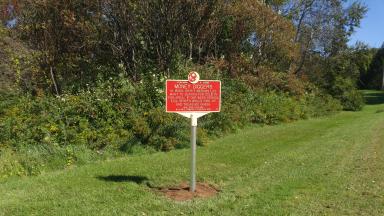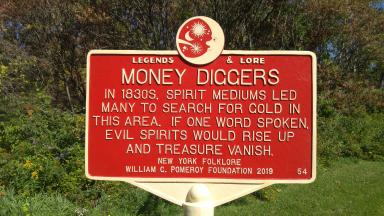A peculiar event transpired in Rose in the Stewart neighborhood. This occurrence can be found in the book Landmarks of Wayne County, New York by George W. Cowles pages 411-412, it is also detailed in the book History of Wayne County, New York by W.H. McIntosh first published in 1877.
“A number of people in this part of the county worked themselves into the delusion that “money-chests” of gold and precious stones lay buried beneath the surface in this town, to which they were guided by invisible spirits through an “medium.” On several farms northeast of Rose Valley they assembled at night and silently dug for the treasure. A single word spoken before it was found was fatal; the treasure would disappear, and the evil spirits would rise against them. In this way the delusion was fed and kept ablaze by those interested, who were always sure to break the silence, when the deluded would run frightened away. On one occasion a kettle was previously buried, and when struck with a spade an exclamation caused the treasure in it to vanish. To these ignorant men this supplied the most absolute proof, and the effects of this foolish delusion are still visible in many places by partially filled excavations, where they labored with a zeal and energy worthy a better cause. There is probably no locality in the world that has not had its, superstition, which the glare of science and education only partially dispels.
The interpreter of the “money-diggers,” as they were called, pretended to see the “Money-chests,” or hidden treasure, through a large, peculiar stone, which he always retained with him. He held it to his eyes, and claimed the power to see through it into the earth. Several visionary citizens of this town, with more strangers who came here regularly, united in their mystic meetings previous to all their diggings. As an inducement to persons predisposed to the marvelous, it was related that the son of a certain minister, then living in town, who was eighteen years of age and of good habits saw, one evening, in his father’s granary, which was lighted up by supernatural light, an image in the form of a “little child.” Then again it appeared in his bed-chamber, and, when addressed by the young man, replied that it was from the “Court of Glory,” and had come to reveal to him the hidden treasures of the earth, and that if he would pray for the span of seven days it would appear the next time in the form of a “beautiful young lady.” In due time the “beautiful young land” appeared and made the promised revelation, the circle was formed, one of the number was made captain, and the digging commenced. Night after night was passed in the hard labor under the particular direction of this invisible spirit. Circles were carefully marked out around the pit to keep the devil out. The money, or a portion of it, was to be used for charitable purposes, and to alleviate the sufferings of humanity. But after many fruitless attempts and much disappointment the captain, becoming incredulous, and losing confidence in the invisible guide, through the interpreter, denounced the “beautiful spirit” as being the devil. Of course this rebellious action could not be tolerated, and must be put down. Accordingly, the captain was notified in writing the appear on a certain day to a trial before the spirits and the circle. On the back of the notice he wrote “protested,” but named a day one week later, when the circle convened and the trial began. Innumerable spirits were seen by the minister and his son, and from ten A.M. to four P.M. the patriarchs of old were called as witnesses, and everything was going against the captain. The last witness was the spirit of Samuel, the prophet. The captain with all his power conjured Samuel to tell the truth and reveal the devil’s work. He was just ready to give up his case when, to his astonishment, and the dismay of the circle, the prophet began performing under his own control. The preacher and his son burst into tears to see poor old Samuel hopping about the room on one foot, then down on the floor, playing bear, with a great load on his back. The captain, having absolute control of the spirit, conjured him to faithfully answer such questions as he should put to him. “Can you at pleasure transform yourself into a ‘devil,’ ‘lamb,’ or ‘young lady?’” Answer, “I can.” “Have you been the only witness here to-day in the form of all the old patriarchs?” Answer, “I have.” “Are you the devil himself?” Answer, “I am.” The captain was triumphant.
The deluded parson, son, and all the circle were ready to give up that it was all the work of the devil. Yet to such an extent did the captain believe in the power of the devil. Yet to such an extent did the captain believe in the power of the devil that he related, as a real occurrence, that a friend of his, while riding, was seized and taken up by the devil, carried through the air seven miles, and after a terrible struggle and fright, was released and dropped in a barn-yard. The captain was sent for, who, with the aid of a physician, restored him. It is stated that many a time while the others were in the pit digging for their “gold” and “money-chests: the devil would appear to he sentry on the watch in the form of a bellowing bull, or by heavy sounds of groaning, or shrieks, which would put the whole party to flight.”


